Freshmen have been excluded from these previews, as we'd like to wait and see what they have to offer on the NCAA level before we come to any long-term conclusions.
-Top 20 Prospects in the Big Ten
-Top 25 Prospects in the ACC
-Top 15 Prospects in the Big 12
-Top 15 Prospects in the Pac-12
-Top Prospects in the Big East #1-5
-Top Prospects in the Big East #6-10
-Top Prospects in the Big East #11-15
#16, Dante Taylor, 6'9, Junior, Power Forward, Pittsburgh
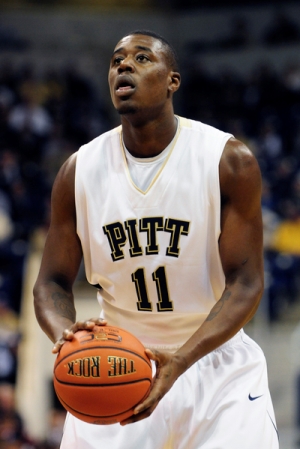
Derek Bodner
Dante Taylor arrived at Pitt as the first McDonalds All-American Pittsburgh the school had signed since Bobby Martin and Brian Shorter all the way back in 1987. Since coming to Pittsburgh, the big man from National Christian Academy in Fort Washignton, Maryland has largely been a disappointment, playing behind the now graduated Gary McGhee during his first two years in Pitt's frontcourt rotation.
A 6'9 power forward with long arms, Taylor struggled through weight and conditioning problems as a freshman, and during his sophomore year, he battled tendinitis in his knee. The combination of the two problems have limited him to some degree athletically compared to the what we saw from him in high school as he doesn't appear to have the lift or lateral mobility he previously displayed.
Taylor still remains one of the best offensive rebounders in the country, and his 5.9 offensive rebounds per- 40 minutes pace adjusted placed him fourth in our database last year. He's able to use his strength, is an instinctive offensive rebounder, and does a good job converting the opportunities he creates for himself around the rim. He also moves fairly well off the ball on cuts to the basket and does an excellent job catching the passes his teammates send his way, showing terrific hands in the process.
Beyond that, Taylor hasn't developed his skills enough, particularly as an offensive player, to live up to the considerable expectations he has had on his shoulders. He has been an opportunistic and efficient scorer during his time at Pitt, but he hasn't generated much of his offense himself. His improvement from his freshman year to his sophomore year has been minimal, showing only a slight uptick in scoring (12.3 points per 40 minutes, pace adjusted, to 14.1), rebounding (11.2 per game to 12.5), and assists (0.4 to 0.9).
His post-game is somewhat methodical and predictable, although he looks capable of being able to establish solid post position. He hasn't shown much away from the basket, either in terms of an ability to hit the mid-range shot or a face-up dribble drive game. In the few instances he has attempted jump shots he's had solid results, but the high arc on his release may make it difficult to extend much beyond mid-range with consistency.
Taylor has made the most progress as a defender, particularly in the post, where he does a very good of denying position early and uses his length to disrupt offensive players. He's capable, albeit not dominant, as a weakside shot blocker, something that he could develop if he improves his conditioning and stays healthy.
Defending away from the basket is something of a weakness, as his lateral quickness would be a concern defending big men in the NBA. Once again, this could have been exacerbated by the weight and knee problems he's had these last two years, and we may not have seen the best he has to offer in this regard.
With Gary McGhee graduated, Dante Taylor has an opportunity to prove his previously lofty rating was deserved. He's reportedly come into the season in much better shape and without the knee pain that troubled him down the stretch last year. If he is able to stay healthy and maintain his playing weight, both very big question marks for a player who has not been able to do either to this point in his career, while showing some development in expanding his offensive skill set, his natural gifts still present an intriguing package, albeit one with considerable question marks.
#17 Kevin Jones, 6'8 , Power Forward, Senior, West Virginia
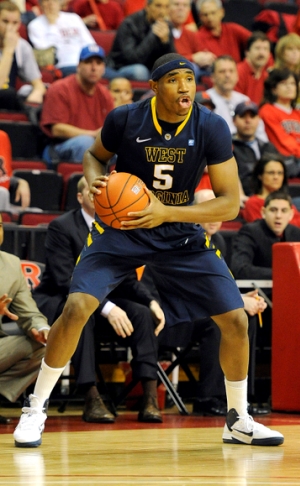
Kyle Nelson
The last time we checked in on Kevin Jones, he was in a the midst of a breakout sophomore campaign, where he emerged as a true inside-outside treat for West Virginia. Jones was less successful as a junior, but still managed to lead West Virginia to a run in the Big East and NCAA Tournaments before declaring for the 2011 NBA Draft. He withdrew from the draft, however, and decided to return for his senior season, where he'll be the best returning scorer on a young and inexperienced West Virginia team.
As we last observed, Jones does not stand out from a physical perspective. He is undersized for both post positions, standing between 6'7 and 6'8, though he does have an excellent wingspan and bulked up to a respectable 247-pournds. That being said, he is an underwhelming athlete and very much a below-the-rim player at this level.
His production per-40 minutes pace adjusted actually decreased during his junior season, despite the fact that he saw more possessions. He still averaged 15.7 points per-40 minutes pace adjusted, but experienced significant dips in both TS% and eFG% while managing to shoot just 44.6% from the field.
According to Synergy Sports Technology, spot-up opportunities consisted of 25.1% of his offensive possessions and he made a mediocre 26.8% of his attempts. Furthermore, while his unorthodox shooting mechanics, resulting from his lack of elevation and slow shooting motion, were acceptable while he was shooting 40.4% from three as a sophomore, he connected on just 30.1% of three-point field goal attempts as a junior. Improving his mechanics would significantly increase his chances at the next level, as NBA teams covet big men who can stretch the floor with their shooting.
Though he is primarily a spot-up shooter, he would be well served to improve his post-game. Though his sub-50% 2FG can partly be attributed to his at times overzealous mid-range shooting exploits, Synergy reveals that he shot just 37.9% on post-up opportunities. On tape, his footwork is improved somewhat, but his skill set is still limited to jump hooks and the occasional drop step. Whether or not he can develop further is questionable, as well, given his age, his still subpar handles, and his lack of explosiveness even at this level.
That being said, Jones hardly ever turns the ball over and he is a very good finisher when West Virginia utilized him in pick-and-roll and pick-and-pop situations.
Jones is actually a solid defender at the collegiate level, especially since he has gotten stronger. While he lacks the lateral quickness to stay with athletic perimeter-oriented power forwards and still struggles to close out shooters, his post defense has improved considerably. He manages to stay in front of his man far better and he does an adequate job of contesting around the basket. Considering his length and solid effort level, he is likely be one of the top returning post defenders in the Big East even if his subpar athleticism is a less than ideal fit at the next level.
While Jones has limited potential, he can boost his stock as a senior with a return to his sophomore form. It is worth mentioning that he thrived as a sophomore alongside of Da'Sean Butler with a stable point guard rotation and noticeably struggled without both as a junior. Though he won't have either as a senior, he has a year and a half of solo experience under his belt and will have the opportunity to prove to scouts that he can better adapt to that pressure. It is obvious that Jones will have to have a standout for West Virginia to continue their recent success, but even if he doesn't he should have a solid professional career overseas as a roleplayer due to his size, ability to stretch the floor, and defense.
#18 Yancy Gates, PF, Senior, 6'9, Cincinnati
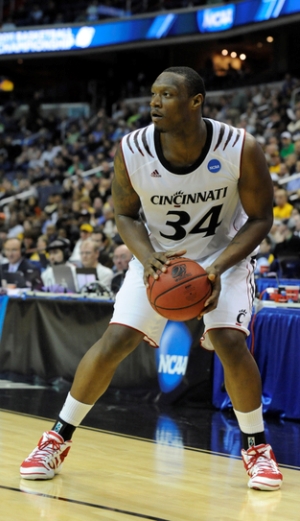
Jeff Rush
Last time we checked in on Yancy Gates, he was coming off the best string of games he's put together as a Bearcat at the 2009 Maui Invitational. While his performance generated some buzz among scouts, the rising senior struggled to capitalize on the attention he received, showing little progress in his game since that point despite intermittent glimpses of the potential that once made him a highly touted prep recruit.
Despite that, Gates remains intriguing, as he is blessed with the size and strength that scouts look for at the power forward position at the next level. He combines his powerful presence with solid footwork and strong, soft hands that rarely miss an opportunity to snatch a bullet pass in traffic or tip in an offensive rebound. While not the type of explosive athlete that will finish over players at the rim, he is capable to using his frame to create space to score inside against long and athletic bigs. Gates has been listed at 6'9 260 lbs. for the past two years, although that seems a little bit on the light side, he has trimmed down since earlier in his career when his propensity to lift weights allowed him to get too heavy at times. He now sports a cut physique that he has no problems throwing around in the paint on both ends of the court.
Gates possesses a skill set that isn't entirely aligned with his size, as he is more than willing to step away from the basket and shoot jumpers. While not a great jump shooter, he does have a nice release and clean form that gives the impression that he is capable of becoming a solid mid-range option despite his 30% accuracy on such attempts according to Synergy Sports Technology. He also has developed a fairly solid feel for the game, as his even assist to turnover ratio indicates. Throughout his three years at Cincinnati his assist totals have risen and his turnover totals have dropped showing an improvement that we don't tend to see from big men as their usage increases at the college level.
In the post, Gates is a load to handle when he's being aggressive, posting up low and wide becoming almost impossible to get around for defenders attempting to deny post entry passes. Once he has the ball he prefers to turn over his left shoulder to a solid jump hook or turnaround jump shot. He is also capable of facing up and putting the ball on the floor to get to the basket from time to time where he uses his wide body to draw contact and get to the line.
Gates does show some nice things in the post when he is dialed in, but is would be nice to see him improve his consistency around the rim, become a bit more versatile down low, and really demand the ball on every possession. He gets a lot of his shots blocked at this point as he tends to go through defenders as opposed to over them, and while has developed a feel for creating enough contact to get himself to the line, he could stand to diversify his post arsenal. His per-40 pace adjusted free throw attempts went from 4.0 his sophomore year to 5.9 his junior year showing that he is developing a feel for how best to use his body to his advantage.
Gates' best trait offensively is the set of strong and soft hands that he uses to collect and finish offensive rebounds. His offensive rebound rate is not incredibly high for a guy his size, but he is especially effective when he corrals those rebounds at finishing them, often with a tip-in. According to Synergy Sports Technology, Gates ranks in the 95th percentile for scoring efficiency off of put-backs among every player in Division I.
Defensively, Gates is very solid both in the post and against guys on the perimeter. He has very good feet that allow him to stay in front of quicker players looking to drive by him on the perimeter or on a face up in the post. He also does a very good job of walling up in the post and making the offensive player shoot a contested shot over him. Much like his assist and turnover numbers, Gates' foul rate has improved in each of his three seasons, dropping to just 3.3 foul per-40 pace adjusted. It is clear that this lowered foul rate is not the result of a lack of effort defensively as Gates averages 1.2 steals and 1.9 blocks per-40 pace adjusted as well.
Overall, Gates may not have exploited the spotlight as thoroughly as recent Maui breakout star Kemba Walker, but he remains a very intriguing prospect because of his huge size and ability to be a solid contributor in multiple phases of the game. He does not have the typical athleticism that you would look for from an NBA power forward, and seems to coast at times, but he has developed a nice feel for what he can do and exploiting that to help his team. It will be very interesting to see what kind of development we will see from Gates this season after three seasons of incremental improvement.
#19 Scoop Jardine, 6'2, Senior, Guard, Syracuse
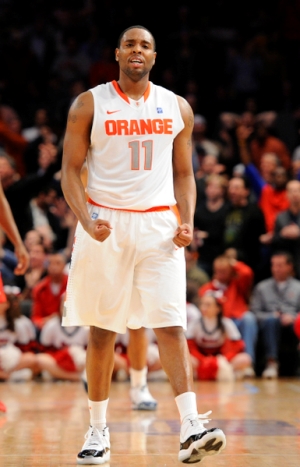
Matt Williams
One of the most productive returning players on a deep and talented Syracuse roster, Scoop Jardine had a busy summer that included time at the Nike Skill Academies and with Team USA and World University games and promised good things during his senior campaign. Like so many Big East guards that have come before him, Jardine has steadily improved from the day he stepped on campus. Though he missed a season due to a stress fracture in his left leg, struggled with his weight for stretches, and had his fair share of struggles in recent seasons, the rising senior has made some positive strides since his high school days that will keep scouts interested as he becomes eligible for the draft.
Standing 6'2 with a dramatically trimmed down frame, Jardine has molded himself into a solid physical specimen. He may not be a dynamic athlete in the open floor or play above the rim on a regular basis, but the Philadelphia native does a nice job off-setting his lack of great explosiveness by being deceptive with his ability to change directions in the paint, using his relative strength advantage against weaker guards, and playing with consistent intensity.
Jardine may not be a high-potential NBA player from a physical perspective, but the 23-year old guard is a polarizing figure for the Orange. He's capable of catalyzing Jim Boeheim's club with his passing and scoring ability or being the key contributor to their struggles when his shot isn't falling and he's playing out of control. Seeing time both on and off the ball, Jardine is not a point guard in the truest sense, though he has that type of impact on his club and will have to play that position at the next level.
When Jardine is at his best, he's a competent scorer in almost every facet of the game. He is a self-made shooter who can score the ball with range off the catch and off the dribble, can convert craftily around the basket despite his athletic limitations, and make life extremely easy for his teammates with his passing. Jardine could stand to improve his consistency from beyond the arc, especially in spot-up situations, by working on his footwork and being a bit more discerning with his shot selection, but he can be a tough cover when his shot is falling because of his feel for using his defenders momentum against him. His lack of elite quickness limits his ability to break down defenses one-on-one unless his defender is forced to close him out, but his court vision is, at times, truly excellent as evidenced by the fact that he ranked among the top players in all of college basketball in assists per-40 minutes pace adjusted.
On the other hand, Jardine struggles at times as well. His consistency from beyond the arc has developed considerably since his freshman season, but his efficiency in catch and shoot situations could use improvement, as he tends to lose his rhythm at times because of the fact that he likes to shoot the ball on the way down. His shot selection leaves a lot to be desired as well, as he forces quite a few contested shots from the perimeter and converts just 46% of his 2 point attempts by being overly-aggressive instead of opportunistic. When Jardine went cold last season, his struggles were often compounded by the fact that every game he makes a few questionable decisions, whether he is driving into a brick wall in the lane or making a poor read when pushing the ball in transition. Considering his assist-to-turnover ratio exceeded 2, it is hard to condemn Jardine's decision-making, but he is capable of better.
Defensively, Jardine is fairly adept at reading the passing lanes in Syracuse's 2-3 zone, but lacks ideal lateral quickness from a NBA perspective. He shows quick hands and is fairly crafty in compensating for his lack of foot speed, but will need to show that he can defend the point guard position competently in workout settings if he wants to get the benefit of the doubt considering the system he's coming out of.
Though Jardine may not be the most glamorous NBA prospect, he is one of the best players on one of the country's best teams. If he can put everything together and have a lights-out season shooting the ball, he could improve his draft stock and put his team in position to reach the Final Four. If he doesn't take a significant stride in terms of his development, he's an ideal candidate for the Portsmouth Invitational Tournament, where he would likely get a chance to showcase his point guard skills and man-to-man defense in front of a broader audience.
#20 Tim Abromaitis, 6-8, Senior, Small Forward, Notre Dame
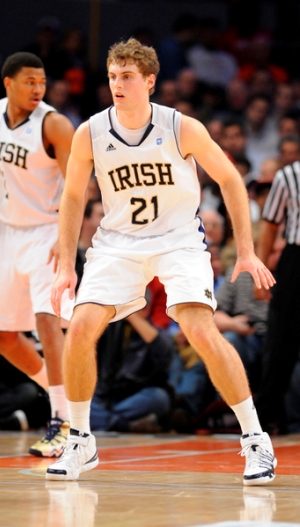
Jonathan Givony
Returning for his fifth and final year at Notre Dame as a redshirt senior, already with an MBA in hand, Tim Abromaitis certainly wasn't viewed as an NBA prospect coming out of high school, but slowly developed into one over time.
Young for his class, he redshirted his sophomore season, electing to spend more time working on his body and skill-set. Abromaitis exploded onto the national landscape the following year, developing into one of the best shooters in college basketball.
While he continued to shoot the ball at a blistering pace, Abromaitis regressed somewhat last year alongside Big East player of the year Ben Hansbrough. His scoring production and efficiency dropped from the previous season, while his #2 seeded Notre Dame team was upset by #10 seed Florida State in the second round of the NCAA tournament.
A two time academic All-American and Big East scholar athlete of the year, Abromaitis will try to use his last year of eligibility to solidify his resume as a NBA draft prospect while attempting to help his team make a deeper run in March to cap off an excellent college career.
Abromaitis has very good size for a small forward at 6-8, to go along with a sturdy frame. He's just an average athlete at best, however, not showing great quickness or explosiveness, which renders him somewhat of a specialist at the college level.
2/3rds of Abromaitis' shot attempts came on jumpers last season, 83% of which he attempted with his feet set. He has excellent shooting mechanics, boasting a high and quick release, and elevates nicely off the floor on each attempt. Also capable of coming off screens, he can get his shot off very effectively thanks to his size, and should have no problem adapting to the NBA 3-point line.
Abromaitis made 43% of his 3-point attempts in each of the past two seasons, making him one of the best returning shooters in all of college basketball.
Unlike most college players, Abromaitis could very well become a more efficient player in the NBA, thanks to the superior spacing he'll enjoy and the fact that he won't be as much of a focal point for opposing defenses as he is at Notre Dame. It will be interesting to see what happens to his efficiency this season with Notre Dame's best ball-handler and shot-creator, Ben Hansbrough, off to the professional ranks.
Outside of his perimeter shooting prowess, Abromaitis is fairly limited. He moves off ball intelligently, doing a good job cutting backdoor for layups when opponents crowd him, but rarely handles the ball and shows very little confidence when he does. His lack of strength and explosiveness makes it difficult for him to finish around the basket in traffic, and he doesn't have any type of post-game he can utilize to take advantage of smaller players guarding him at the small forward position.
Defensively, Abromaitis is a smart player with solid anticipation skills and usually puts a decent effort in. With that said, he has a hard time not emerging as somewhat of a liability at the college due to his limited athleticism, as his combination of poor lateral quickness and high center of gravity makes it difficult for him to stay in front of most guards and wings in isolation situations. Notre Dame is able to overcome that at times by playing him at the power forward position, but that's not going to be a great option in the NBA. For him to have any chance of seeing consistent minutes on an NBA team that values defensive play, he'll need to show a consistently high intensity level and continue to work on his technique to maximize his potential on this end of the floor.
A player with very clear cut strengths and weaknesses, Abromaitis is a niche player who could find a spot in the rotation of a team looking for a player in his mold. We've seen similarly one-dimensional shooters like Andy Rautins and Jon Diebler drafted over the last two years, and Abromaitis has better size than those two. There are plenty of players in this mold such as Kyle Korver, James Jones, Steve Novak and others who have carved out niches in the NBA, although there as just as many if not far more who ended up playing overseas.













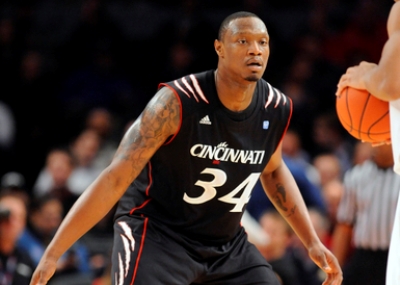


























Comments